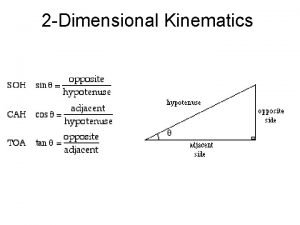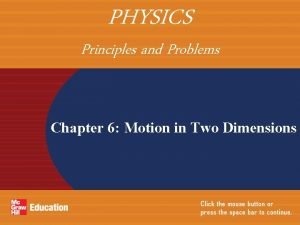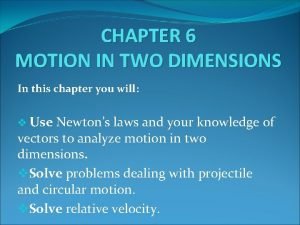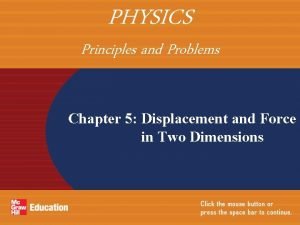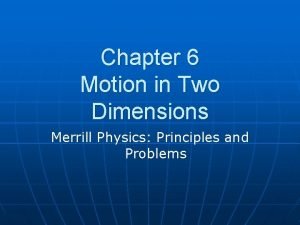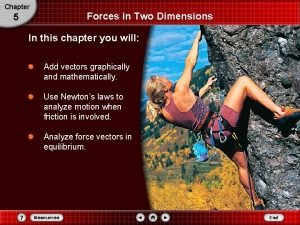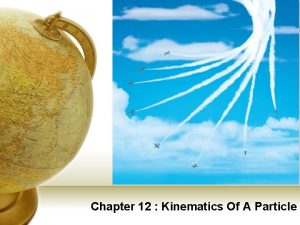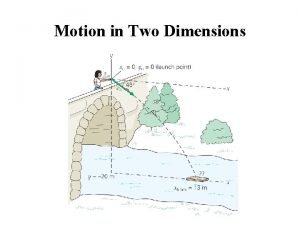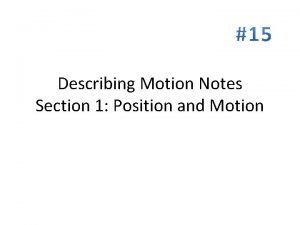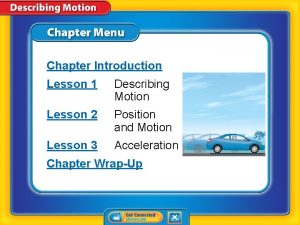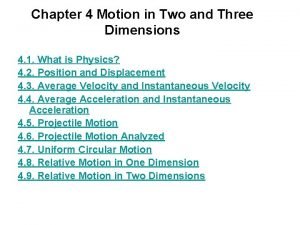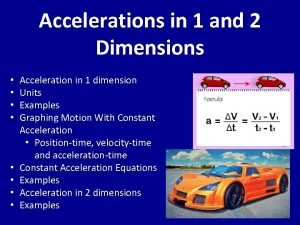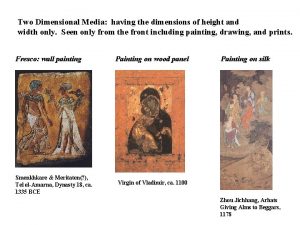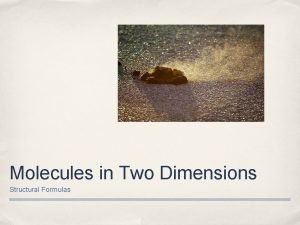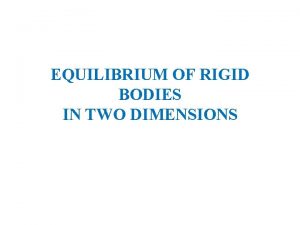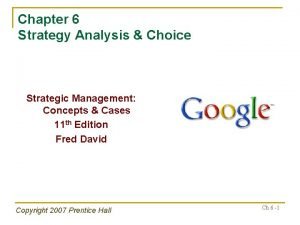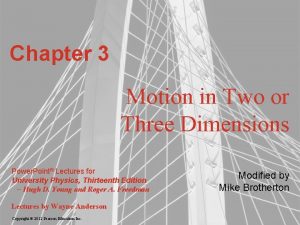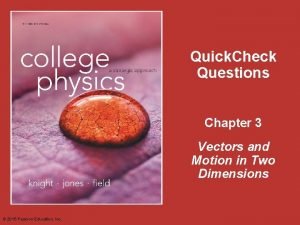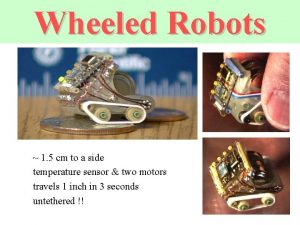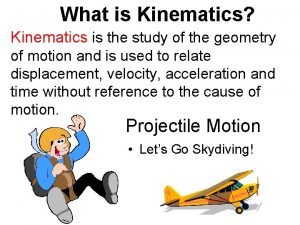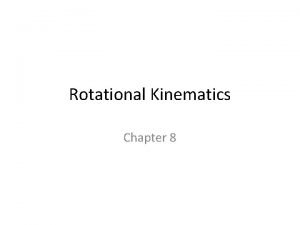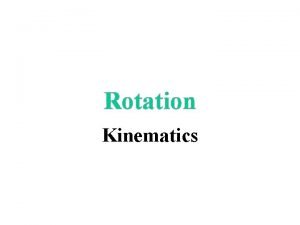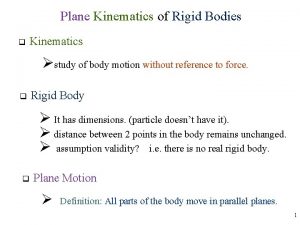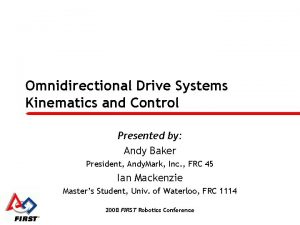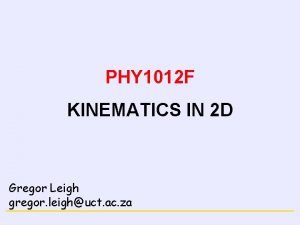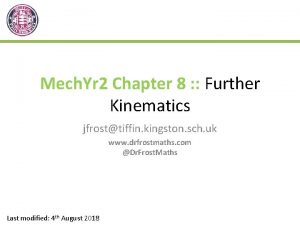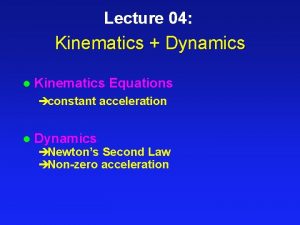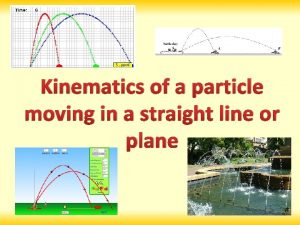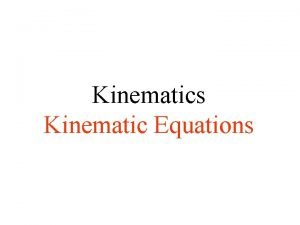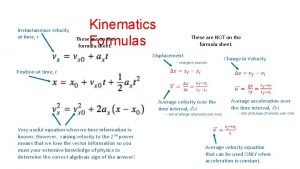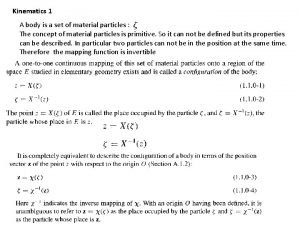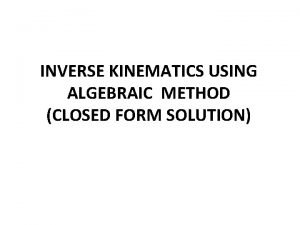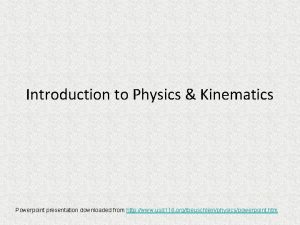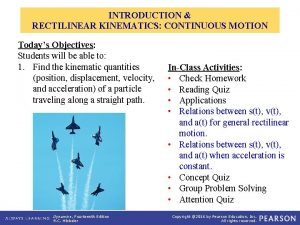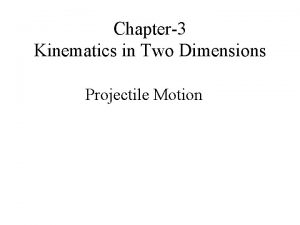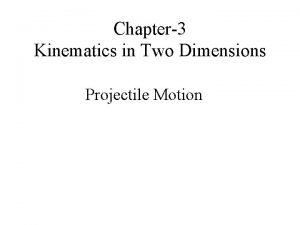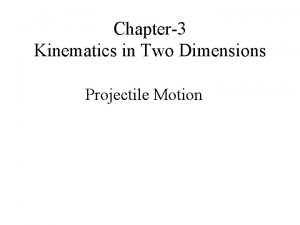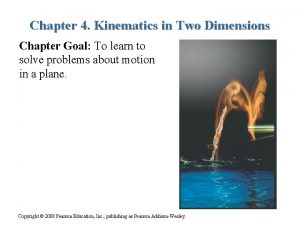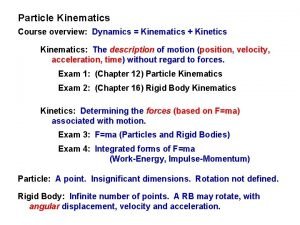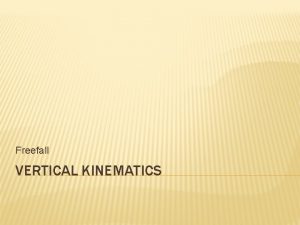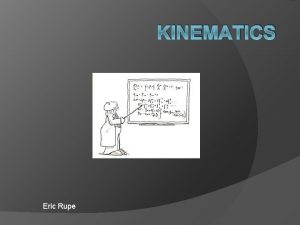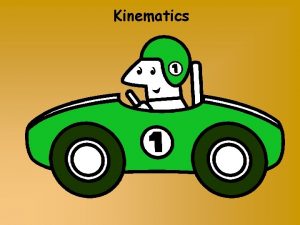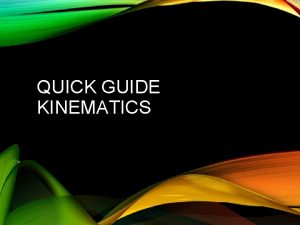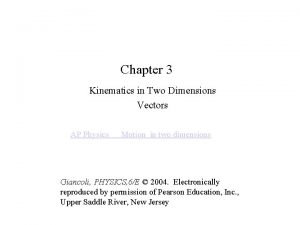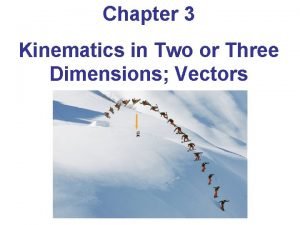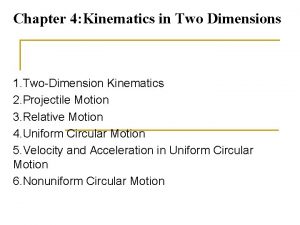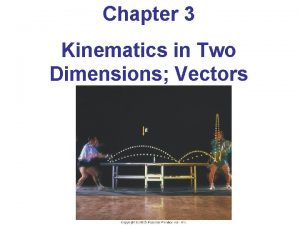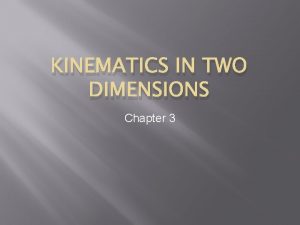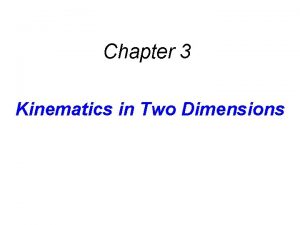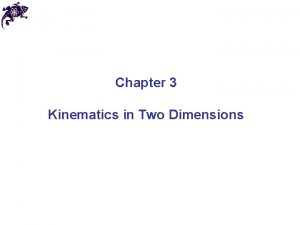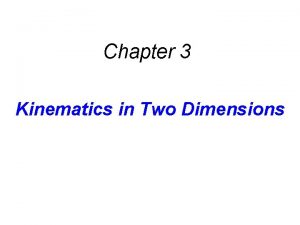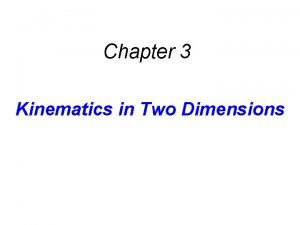Chapter 4 Kinematics in Two Dimensions Chapter Goal










































- Slides: 42

Chapter 4. Kinematics in Two Dimensions Chapter Goal: To learn to solve problems about motion in a plane. Copyright © 2008 Pearson Education, Inc. , publishing as Pearson Addison-Wesley.

Ch. 4 - Student Learning Objectives • To identify the acceleration vector for curvilinear motion. • To compute two-dimensional trajectories. • To read and interpret graphs of projectile motion. • To solve problems of projectile motion using kinematics equations. • To understand the kinematics of uniform and nonuniform circular motion. Copyright © 2008 Pearson Education, Inc. , publishing as Pearson Addison-Wesley.

Acceleration in two dimensions This acceleration vector will cause the particle to: A: slow down in the direction it’s going. B. slow down and curve to the left C. reverse direction D. turn left at a constant speed Copyright © 2008 Pearson Education, Inc. , publishing as Pearson Addison-Wesley.

• What happens when acceleration is constant along one axis and zero along the other? Copyright © 2008 Pearson Education, Inc. , publishing as Pearson Addison-Wesley.

Acceleration is constant along one axis and zero along another A toy rocket ship is launched with a constant vertical acceleration of 8 m/s 2 from a rolling cart with an initial horizontal velocity of 2 m/s. Draw a graph of this particle’s trajectory for t = 0, 1, 2, 3, 4 and 5 s. Label the x, y coordinates of each point. What is the shape of the trajectory? Copyright © 2008 Pearson Education, Inc. , publishing as Pearson Addison-Wesley.

Acceleration is constant along one axis and zero along another A toy rocket ship is launched with a constant vertical acceleration of 8 m/s 2 from a rolling cart with an initial velocity of 2 m/s. What does the slope at a given point indicate? Copyright © 2008 Pearson Education, Inc. , publishing as Pearson Addison-Wesley.

Slope of the trajectory graph • The value of the slope equals (dy/dx) which is NOT equal to the magnitude of the velocity. • If the slope is horizontal, the object has not stopped, its going in a horizontal direction • The angle of the slope indicates the direction of motion; therefore: tan θ = vy /vx Copyright © 2008 Pearson Education, Inc. , publishing as Pearson Addison-Wesley.

Compare these two graphs • The position vs time graph (left) looks similar to the trajectory graph. • The value of the slope for the p vs t graph = ds/dt. This IS the value of the velocity (when that slope is horizontal, v=0). • The value of the slope of the p vs t graph does not indicate direction. Copyright © 2008 Pearson Education, Inc. , publishing as Pearson Addison-Wesley.

A rocket-powered hockey puck moves on a frictionless horizontal table. It starts at the origin. At t=5 s, vx = 40 cm/s. a. In which direction is the puck moving at t = 2 s? Give your answer as an angle from the x-axis. b. How far from the origin is the puck at t = 5 s? Copyright © 2008 Pearson Education, Inc. , publishing as Pearson Addison-Wesley.

A rocket-powered hockey puck moves on a frictionless horizontal table. It starts at the origin. At t=5 s, vx = 40 cm/s. a. In which direction is the puck moving at t = 2 s? Give your answer as an angle from the x-axis. 62 degrees b. How far from the origin is the puck at t = 5 s? 180 cm Copyright © 2008 Pearson Education, Inc. , publishing as Pearson Addison-Wesley.

Projectile motion on another planet A student on planet Exidor throws a ball that follows a parabolic trajectory as shown. The ball’s position is shown at 1 second intervals until t = 3 s. At t=1 s, the ball’s velocity is the value shown. a. Determine the ball’s velocity at t = 0, 2, and 3 seconds. b. Determine the value of g on Exidor. c. Determine the angle at which the ball was thrown. Copyright © 2008 Pearson Education, Inc. , publishing as Pearson Addison-Wesley.

Copyright © 2008 Pearson Education, Inc. , publishing as Pearson Addison-Wesley.

Projectile motion on another planet |g| = 2 m/s 2 θ = tan-1 (v 0 y/v 0 x) = 630 Copyright © 2008 Pearson Education, Inc. , publishing as Pearson Addison-Wesley.

Throwing a ball • A ball is thrown up toward a cliff of height h with a speed of 30 m/s and an ang/e of 60 degrees above horizontal. It lands on the edge of the cliff 4. 0 seconds later. A. How high is the cliff? B. What was the maximum height of the ball above the ground C. What is the impact speed? Copyright © 2008 Pearson Education, Inc. , publishing as Pearson Addison-Wesley.

Throwing a ball • A ball is thrown up toward a cliff of height h with a speed of 30 m/s and an angle of 60 degrees above horizontal. It lands on the edge of the cliff 4. 0 seconds later. A. How high is the cliff? – 25. 5 m B. What was the maximum height of the ball above the ground? 34. 4 m C. What is the impact speed? – 20 m/s Copyright © 2008 Pearson Education, Inc. , publishing as Pearson Addison-Wesley.

The water hose Water from a garden hose pointed 25° above horizontal, lands directly on a sunbather lying on the ground 4. 4 m away in the horizontal direction. The nozzle is held 1. 4 m above the ground. At what speed does the water leave the nozzle? Copyright © 2008 Pearson Education, Inc. , publishing as Pearson Addison-Wesley.

The water hose Water from a garden hose pointed 25° above horizontal, lands directly on a sunbather lying on the ground 4. 4 m away in the horizontal direction. The nozzle is held 1. 4 m above the ground. At what speed does the water leave the nozzle? 5. 78 m/s Copyright © 2008 Pearson Education, Inc. , publishing as Pearson Addison-Wesley.

Uniform Circular Motion Period (T) – the time it takes to go around the circle once. The SI units of T are seconds (per cycle, or per revolution) The reciprocal of T are rps, revolutions per second Copyright © 2008 Pearson Education, Inc. , publishing as Pearson Addison-Wesley.

Uniform Circular Motion – motion around a circle at constant speed • For a particle traveling in circular motion, we can describe it’s position by distance from origin, r, and angle θ, in radians: θ = s/r where s is the arc length (meters) and r is the radius of the circular motion (also in meters). • The unit of radians is dimensionless. There are 6. 28 (2π) radians in a circle. • By convention, counterclockwise direction is positive. Copyright © 2008 Pearson Education, Inc. , publishing as Pearson Addison-Wesley.

Uniform Circular Motion Copyright © 2008 Pearson Education, Inc. , publishing as Pearson Addison-Wesley.

Compare graphs Copyright © 2008 Pearson Education, Inc. , publishing as Pearson Addison-Wesley.

Uniform Circular Motion - Velocity Translational Angular pos: s meters θ = s/r radians vel: ds/dt = v (m/s) dθ/dt = v/r = ω rads/s (s-1) Copyright © 2008 Pearson Education, Inc. , publishing as Pearson Addison-Wesley.

A particle moves cw around a circle at constant speed for 2. 0 s. It then reverses direction and moves ccw at half the original speed until it has traveled through the same angle. Which is the particle’s angle-versus-time graph? Copyright © 2008 Pearson Education, Inc. , publishing as Pearson Addison-Wesley.

A convenient coordinate system for circular motion – the rtz system Copyright © 2008 Pearson Education, Inc. , publishing as Pearson Addison-Wesley.

Circular Motion – Velocity Vector Components Consider the velocity vector The components are vr = 0, therefore |vt | = where r denotes radial component and t denotes tangential component. For tangential components, ccw = positive, cw = negative. For radial components, positive is into the center of the circle. Copyright © 2008 Pearson Education, Inc. , publishing as Pearson Addison-Wesley.

Uniform Circular Motion – direction of acceleration vector Copyright © 2008 Pearson Education, Inc. , publishing as Pearson Addison-Wesley.

Acceleration of Uniform Circular motion Consider the acceleration vector, graphical vector subtraction shows that for uniform circular motion: at = 0 (vt constant) ar = The magnitude of ar is: ar = v 2/r or ar = ω2 r • ar is centripetal acceleration • The magnitude of ar is constant, but direction is not • Cannot use ar in kinematic equations Copyright © 2008 Pearson Education, Inc. , publishing as Pearson Addison-Wesley.

Rank in order, from largest to smallest, the centripetal accelerations (ar)a to (ar)e of particles a to e. Copyright © 2008 Pearson Education, Inc. , publishing as Pearson Addison-Wesley.

EOC #29, more or less Your roommate spins the 60 -cm diameter bicycle wheel while working on his bicycle. You notice that a stone is stuck in the tread. It goes by 3 times every second. Find T, ω (in SI units), vt and ar for the stone: Copyright © 2008 Pearson Education, Inc. , publishing as Pearson Addison-Wesley.

EOC #29 - answer Your roommate spins the 60 -cm diameter bicycle wheel while working on his bicycle. You notice that a stone is stuck in the tread. It goes by 3 times every second. Find T, ω, vt and ar for the stone: T = 0. 33 s/rev ω = 19 rads/s vt = 5. 7 m/s ar = 108 m/s 2 Copyright © 2008 Pearson Education, Inc. , publishing as Pearson Addison-Wesley.

Nonuniform Circular Motion If the object changes speed: at = dv/dt ar = v 2/r where v is the instantaneous speed. if at is constant, arc length s and velocity vt can be found with kinematic equations. Copyright © 2008 Pearson Education, Inc. , publishing as Pearson Addison-Wesley.

Nonuniform Circular Motion For non-uniform circular motion: • the acceleration vector no longer points towards the center of the circle. • at can be positive (ccw) or negative (cw) but ar is always positive. Copyright © 2008 Pearson Education, Inc. , publishing as Pearson Addison-Wesley.

EOC #34 A car speeds up as it makes a circular turn from heading due south to heading due east. When exactly halfway around the curve (heading southeast) his total acceleration is 3. 0 m/s 2, 20 degrees north of east. What are the magnitudes of the radial and tangential components of his acceleration? What is the cardinal direction of each component? Southeast is 45 degrees from due east. Copyright © 2008 Pearson Education, Inc. , publishing as Pearson Addison-Wesley.

EOC #34 • A car speeds up as it makes a circular turn from heading due south to heading due east. When exactly halfway around the curve (heading southeast) his total acceleration is 3. 0 m/s 2, 20 degrees north of east. What are the magnitudes of the radial and tangential components of his acceleration? What is the cardinal direction of each component? Southeast is 45 degrees from due east. • Ans: radial: 2. 7 m/s 2, northeast • tangential 1. 27 m/s 2, southeast Copyright © 2008 Pearson Education, Inc. , publishing as Pearson Addison-Wesley.

Angular Acceleration at = dv/dt where v = vt vt = r ω at = r dω/dt The quantity dω/dt is defined as the angular acceleration: α = dω/dt, in rad/s 2 at = r α Copyright © 2008 Pearson Education, Inc. , publishing as Pearson Addison-Wesley.

Angular Acceleration • the graphical relationships for angular velocity and acceleration are the same as those for linear velocity and acceleration Copyright © 2008 Pearson Education, Inc. , publishing as Pearson Addison-Wesley.

Comparisons for accelerated circular motion translational motion angular motion pos: s meters θ = s/r radians vel: dθ/dt = v/r = ω rads/s (s-1) ds/dt = v m/s acc: dv/dt = at m/s 2 dω/dt = at/r = α rads/s 2 Copyright © 2008 Pearson Education, Inc. , publishing as Pearson Addison-Wesley.

Angular Acceleration if α is constant, θ and ω can be found with the angular equivalents of the kinematic equations. Copyright © 2008 Pearson Education, Inc. , publishing as Pearson Addison-Wesley.

Crankshaft slowing down A 3. 0 cm diameter crankshaft that is rotating at 2500 rpm slows to a stop at a constant rate in 1. 5 s. a. What is the magnitude of the tangential acceleration (at) of a point on the surface? b. What is the centripetal acceleration after 1. 0 s? c. How many revolutions does the crankshaft make as it stops? Copyright © 2008 Pearson Education, Inc. , publishing as Pearson Addison-Wesley.

Crankshaft slowing down a. What is the magnitude of the tangential acceleration (at) of a point on the surface? 2. 62 m/s 2 b. What is the centripetal acceleration after 1. 0 s? 114. 3 m/s 2 c. How many revolutions does the crankshaft make as it stops? 31. 3 revolutions Copyright © 2008 Pearson Education, Inc. , publishing as Pearson Addison-Wesley.

The fan blade is slowing down. What are the signs of ω and α, respecitively? a. Pos, pos b. Pos, neg c. Neg, pos d. Neg, neg Copyright © 2008 Pearson Education, Inc. , publishing as Pearson Addison-Wesley.

Relationship between angular and tangential quantities • Point 1 and 2 on the rotating wheel have different radii. θ 1 = θ 2 but s 1 ≠ s 2 ω1=ω2 but v 1 ≠ v 2 α 1= α 2 but at 1 ≠ at 2 Copyright © 2008 Pearson Education, Inc. , publishing as Pearson Addison-Wesley.
 Aplusphysics kinematics-horizontal kinematics
Aplusphysics kinematics-horizontal kinematics Salmon often jump waterfalls to reach
Salmon often jump waterfalls to reach Physics: principles and problems chapter 6 answers
Physics: principles and problems chapter 6 answers Chapter 6 study guide motion in two dimensions
Chapter 6 study guide motion in two dimensions Chapter 6 motion in two dimensions
Chapter 6 motion in two dimensions 5 displacement and force in two dimensions
5 displacement and force in two dimensions Chapter 6 motion in two dimensions
Chapter 6 motion in two dimensions Chapter 5 forces in two dimensions study guide answers
Chapter 5 forces in two dimensions study guide answers Chapter 12 kinematics of a particle solutions
Chapter 12 kinematics of a particle solutions Acceleration in two dimensions
Acceleration in two dimensions Two dimensions of political ideologies
Two dimensions of political ideologies Displacement formula projectile motion
Displacement formula projectile motion Describing motion notes
Describing motion notes Chapter 1 lesson 2 describing motion answer key
Chapter 1 lesson 2 describing motion answer key Motion in two and three dimensions
Motion in two and three dimensions Acceleration in two dimensions
Acceleration in two dimensions What is two-dimensional media
What is two-dimensional media Molecules in two dimensions structural formulas
Molecules in two dimensions structural formulas Equilibrium of rigid bodies
Equilibrium of rigid bodies Chapter 6 strategy analysis and choice
Chapter 6 strategy analysis and choice Motion in two or three dimensions
Motion in two or three dimensions Two dimensions of spiral model
Two dimensions of spiral model Vectors quick check
Vectors quick check Motion diagram physics
Motion diagram physics 2^x=256
2^x=256 Tricycle kinematics
Tricycle kinematics Kinematics is the study of
Kinematics is the study of Two dimensional motion and vectors
Two dimensional motion and vectors Rotational motion equations
Rotational motion equations Rotational motion equations
Rotational motion equations Plane kinematics of rigid bodies
Plane kinematics of rigid bodies Holonomic drive
Holonomic drive Range motion
Range motion Dr frost further kinematics
Dr frost further kinematics Equation of kinematics
Equation of kinematics Kinematics of a particle moving in a straight line answers
Kinematics of a particle moving in a straight line answers Kinematic equation for projectile motion
Kinematic equation for projectile motion Kinematics formulas sheet
Kinematics formulas sheet Transport theorem kinematics
Transport theorem kinematics Inverse kinematics algebraic method
Inverse kinematics algebraic method Robot planar
Robot planar Kinematics powerpoint
Kinematics powerpoint Rectilinear kinematics continuous motion
Rectilinear kinematics continuous motion

